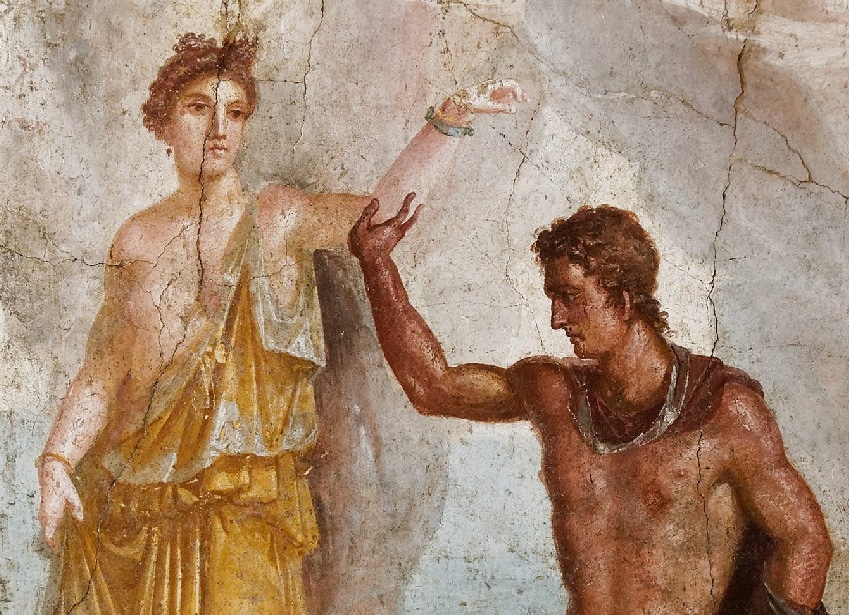
Table of Contents
Perseus was one of ancient Greece’s greatest heroes, known for his amazing feats and for being the ancestor of the royal houses of Sparta, Elis, and Mycenae. His most famous myth involves beheading the Gorgon, Medusa and using her head as a weapon in his later adventures. Let’s take a closer look at his story.
Who Was Perseus?
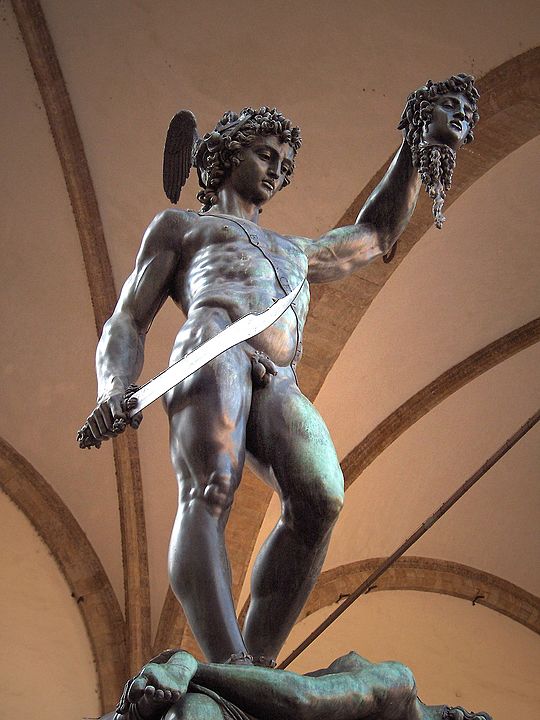
Perseus was a demigod born of a mortal and a god. His father was Zeus, the god of thunder, and his mother the daughter of King Acrisius of Argos, Danae.
The Prophesy of Perseus’ Birth
According to Greek mythology, Acrisius, King of Argos, received a prophecy from an oracle, which said that one day his grandson would kill him. Conscious of this prophecy, the king had his daughter Danae imprisoned in a bronze chamber underground to prevent her from conceiving. However, Zeus, who was attracted to Danae, wasn’t deterred by this. He entered the bronze chamber in the form of a golden shower through a crack in the roof and managed to get Danae pregnant.
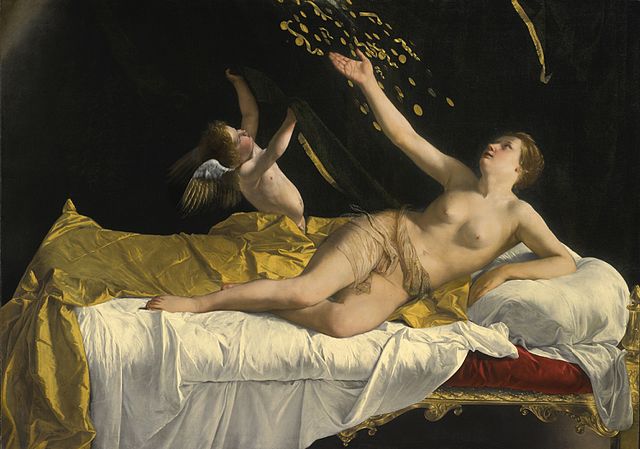
Banishment from Argos and Safety in Seriphos
Acrisius would not believe the story of his daughter and enraged by the birth of Perseus, he threw the princess and her son into the ocean in a wooden chest and thus banished her from Argos. Zeus, however, would not abandon his son and requested of Poseidon to ease the tides.
The wooden chest was carried easily to the coast of the island of Seriphos, where a fisherman called Dictys found it. Dictys, who happened to be the brother of Polydectes, king of Seriphos, offered Danae and her son shelter and helped to raise Perseus. It was here that Perseus spent his formative years.
Perseus and King Polydectes
Since his early childhood, Perseus amazed the people of Argos with his physical strength and bravery, and King Polydectes was no exception. According to the myths, the king fell in love with Perseus’ mother, but he knew that in order to woo Danae, he needed to get rid of the hero first. Perseus didn’t approve of Polydectes and wished to protect Danae from him. There appear to be two versions of how Polydectes gets rid of Perseus:
- King Polydectes saw the opportunity to send the hero away when Perseus boasted about being able to slay Medusa, the only mortal Gorgon. He commanded Perseus to kill the Gorgon and bring the head back to him. If the hero failed, he would take his mother as a prize.
- According to other sources, Polydectes held a banquet and asked his guests to each bring a horse as gifts for his intended bride, Hippodamia. This was a ploy because he knew that Perseus had no horse. Perseus, instead, promised Polydectes to bring him any gift he desired. Taking him up on this, Polydectes requested Perseus to bring him the head of Medusa.
It’s likely that the king commanded Perseus with this impossible task so that he wouldn’t succeed and would probably be killed in the process. However, this command led Perseus to pursue one of the greatest quests of Greek mythology.
Perseus and Medusa
The Gorgons were a group of three sisters, of whom Sthenno and Euryales were immortal, but Medusa was not. Medusa’s story is intriguing and closely tied to that of Perseus. Medusa was a beautiful woman whom both gods and mortals found attractive, but she rejected their advances.
One day, she attracted the interest of Poseidon, god of the sea, who wouldn’t take no for an answer. She ran from him and took shelter in Athena’s temple, but Poseidon followed her and had his way with her.
The sacrilege on her temple enraged Athena, who punished Medusa and her sisters (who’d tried to save her from Poseidon) by turning them into Gorgons – hideous monsters with live, writhing snakes for hair. The myths say that just a look of the deadly Gorgons was enough to turn men into stone, making the task of attacking them difficult. The Gorgons dwelt in a dark cave on the island of Cisthene.
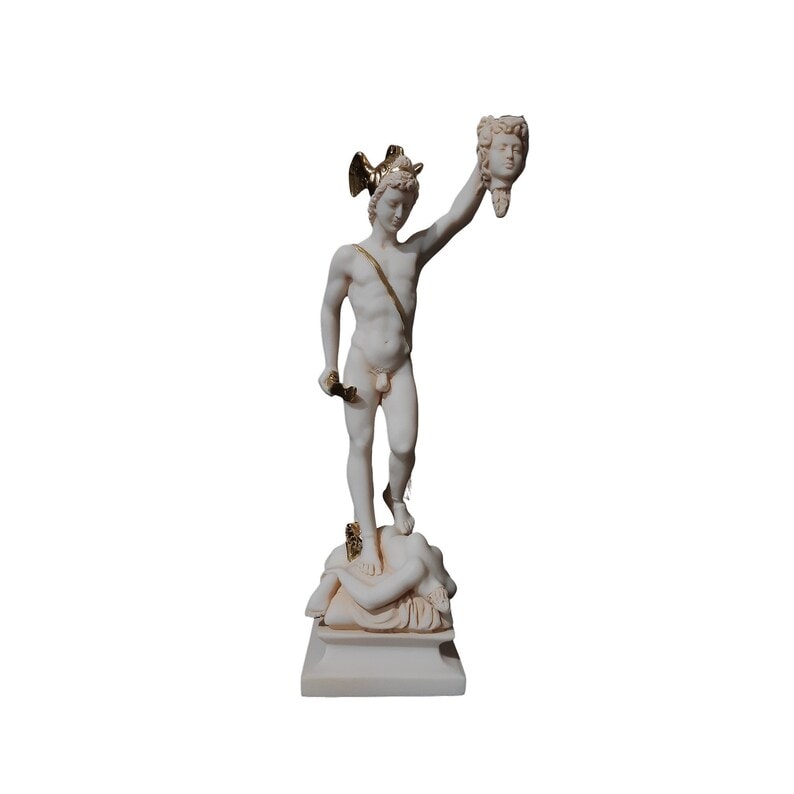
The Gorgons were known for preying on mortals and terrorizing the area. Thus, they had to be killed.
The Gods Help Perseus
The gods helped Perseus on his quest to kill Medusa by giving him gifts and weapons that would support him. Hermes and Athena advised he seek counsel from the Graeae, who were the sisters of the Gorgons, known for sharing one eye and one tooth between the three of them. They could direct him to the cave where the Gorgons lived.
Upon finding the Graeae, Perseus stole the eye and the tooth they shared and forced them to give him the information he wanted, if they wanted their tooth and eye back. The Graeae had no choice but to oblige.
The Graeae led Perseus to visit the Hesperides, who had the equipment he needed to succeed against Medusa. Perseus then returned their eye and tooth he had taken from them.
The Hesperides gave Perseus a special bag in which he could keep the deadly head of Medusa once decapitated. In addition to this, Zeus gave him the Cap of Hades, which would render him invisible when worn, and an adamantine sword. Hermes lent Perseus his famous winged sandals, which would give him the ability to fly. Athena gave Perseus a reflecting shield, from which he could look at Medusa without direct eye contact.
Armed with his special equipment, Perseus was ready to meet the Gorgon.
Below is a list of the editor’s top picks featuring Perseus’s statue.
Medusa’s beheading
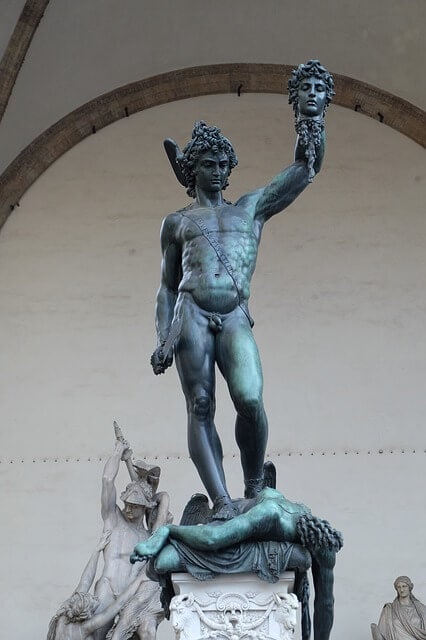
Once Perseus had reached the cave, he found Medusa asleep and took the opportunity to attack. He used the winged sandals to fly so that his steps could not be heard and used the shield to look at Medusa without exposing himself to her murderous stare. He used the adamantine sword to behead her.
At the time of the beheading, Medusa is said to have been pregnant with Poseidon’s offspring. When the blood sprang out of Medusa’s lifeless body, Chrysaor and Pegasus were born from it.
By the time the other Gorgon sisters, Sthenno and Euryales, realized what had happened and rushed after Perseus, he had already bagged Medusa’s head and fled the scene with his winged sandals.
Most artistic depictions of Perseus showcase him either beheading Medusa and holding up her severed head or flying off, wearing Hades’ hat and the winged sandals.
Perseus and Andromeda
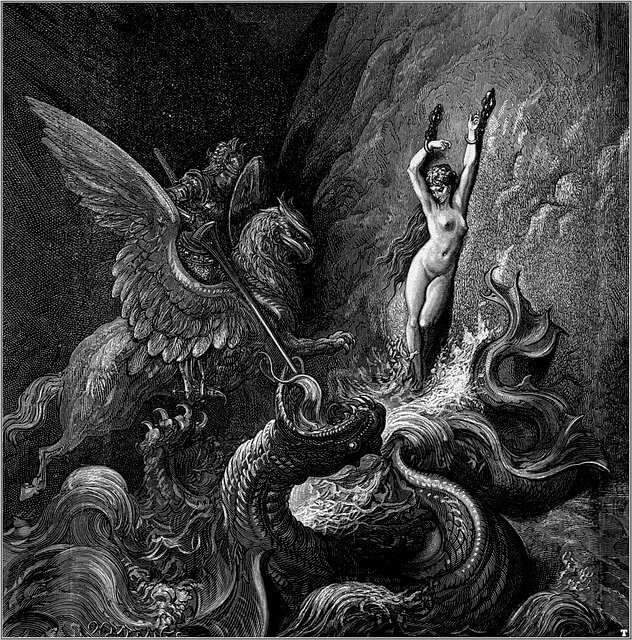
On his way home with Medusa’s head, Perseus came across the Ethiopian princess Andromeda, a beautiful woman who had been offered as a virgin sacrifice to appease Poseidon.
Andromeda’s mother, Queen Cassiopeia, had bragged about the beauty of her daughter, considering her beauty superior to that of the Nereids, the sea nymphs. The Nereids, in anger at Cassiopeia’s hubris, asked Poseidon to punish the insolence of the queen. He acquiesced and did this by flooding the land and sending Cetus, a sea monster, to ravage it.
When the King Cepheus, Andromeda’s father, consulted the Oracle Ammon, he advised them to offer Andromeda to the monster to ease the wrath of Poseidon. The princess was chained naked to a rock and was left there to for Cetus to devour her.
Perseus, flying by on his winged sandals, saw the princess’ plight. He immediately fell in love with her and wanted to rescue her. Perseus stepped in front of the monster and used Medusas’ head to turn into stone. Although dead, Medusa’s power was such that her severed head could still turn those who saw it into stone. He then married Andromeda and they left together to Seriphos.
Perseus Returns to Seriphos
The myths say that by the time Perseus returned to Seriphos, King Polydectes had enslaved and harassed the hero’s mother. Perseus used the head of Medusa and turned him into stone to make him pay. He freed his mother and made Dictys the new king and consort of Danae.
Perseus returned all the special gifts he had been given by the gods, including Medusa’s head, which he gave to Athena. Athena placed the head on her shield, where it became known as the Gorgoneion.
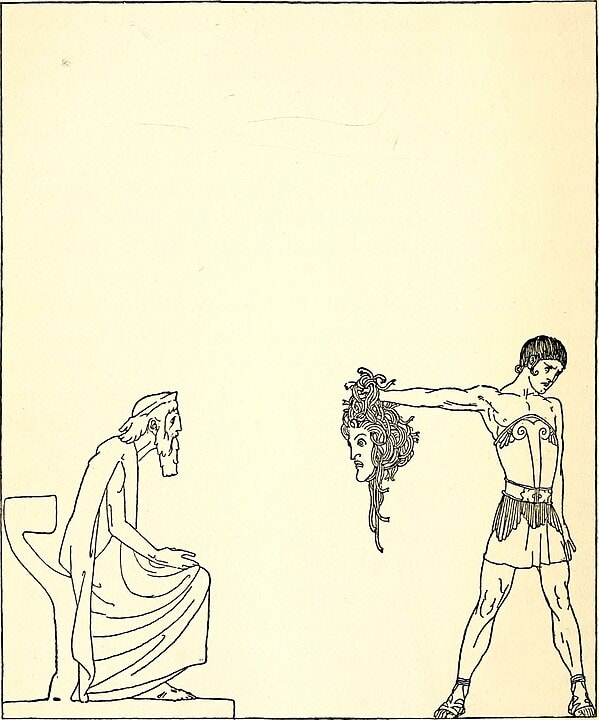
The Prophesy is Fulfilled
Perseus returned to Argos, but when Acrisius found out that his grandson was returning, he fled in fear, not knowing what his intentions were. There are at least three different variations of how Perseus fulfilled the prophecy and killed Acrisius.
The most popular version states that Perseus visited Larissa on his way to Argos and took part in some funeral games held for the king’s dead father. Perseus competed in the discuss throw, but the discuss accidently struck and killed Acrisius, who had been in hiding from Perseus in Larissa.
Perseus in Later Life
Perseus didn’t become the ruler of Argos, which was his rightful throne, but instead went off and founded Mycenae. He and Andromeda ruled over Mycenae, where they had several children, including Perses, Alcaeus, Heleus, Mestor, Sthenelus, Electryon, Cynurus, Gorgophone and Autochthe. Of his offspring, Perses went on to become the founder of the Persians, while the others ruled in various capacities. Perseus’ great-grandson would be Heracles, the greatest Greek hero of them all, indicating that greatness ran in the bloodline.
Perseus in Art and Modern Entertainment
Perseus was a popular figure in art, often depicted in paintings and sculptures. The bronze statue of Perseus holding up Medusa’s head, created by Benvenuto Cellini, is one of the most notable.
In the 21st Century, the image of Perseus has been used repeatedly in novels, series, and movies. Rick Riordan’s saga Percy Jackson and the Olympians is mostly based on the reincarnation of Perseus, and it shows some of his deeds in a modern retelling that differs somewhat from the myths.
The movie Clash of the Titans and its sequel both star the Greek hero and portray his greatest feats including the beheading of Medusa and the saving of Andromeda.
Several of the main characters in Perseus’ myths can be found as constellations in the night sky, including Andromeda, Perseus, Cepheus, Cassiopeia and Cetus, the sea monster.
Perseus Facts
Perseus’ parents were the god Zeus and the mortal Danae.
Perseus’ consort is Andromeda.
Perseus has several siblings on Zeus side, including many of the major gods such as Ares, Apollo, Athena, Artemis, Hephaestus, Heracles, Hermes and Persephone.
Perseus and Andromeda had several children, including Perses, Alcaeus, Heleus, Mestor, Sthenelus, Electryon, Cynurus, Gorgophone and Autochthe.
Perseus is most commonly depicted as holding Medusa’s head, which has become his symbol.
No, Perseus was the son of a god, but he wasn’t a god himself. He was a demi-god but is known as a great hero.
Perseus most famous actions include killing Medusa and rescuing Andromeda.
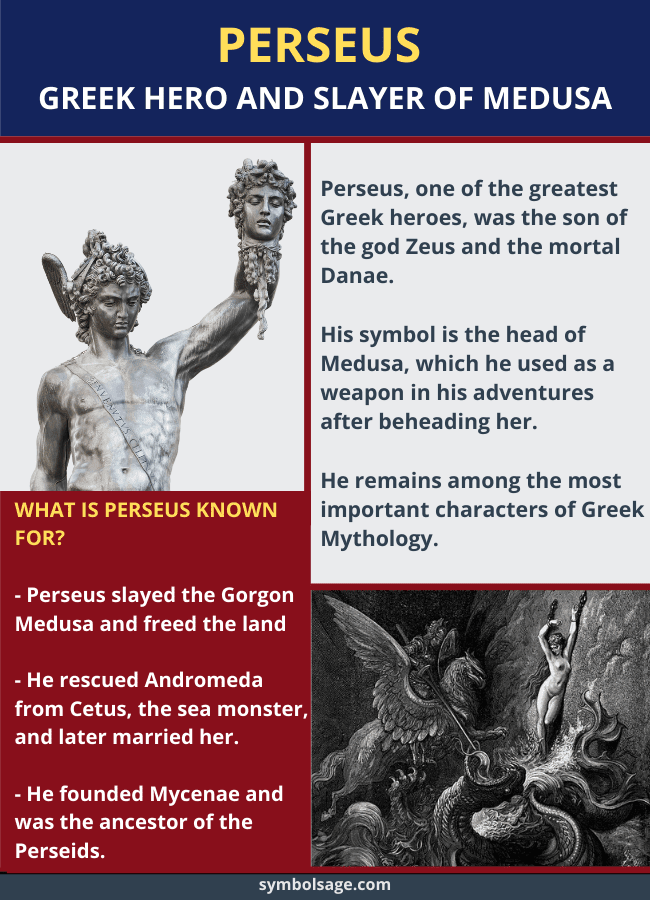
In Brief
Perseus was not only a great hero but also the beginning of a family tree that would rule ancient Greece and last for centuries. For his deeds and his descendants, Perseus stepped strongly into Greek mythology and remained one of antiquity’s most important heroes.











